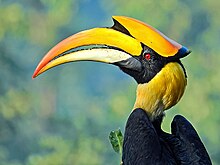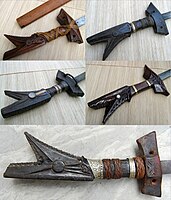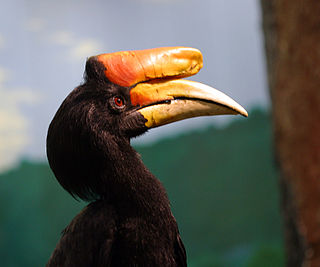
Buceros is a genus of large Asian hornbills.

The southern ground hornbill is one of two species of ground hornbill, both of which are found solely within Africa, and is the largest species in the hornbill order worldwide. It can be found in the southern regions of Africa, ranging from Kenya to South Africa. Within these regions, they inhabit both woodlands and savannas. The other species of the genus Bucorvus is the Abyssinian ground hornbill, B. abyssinicus.
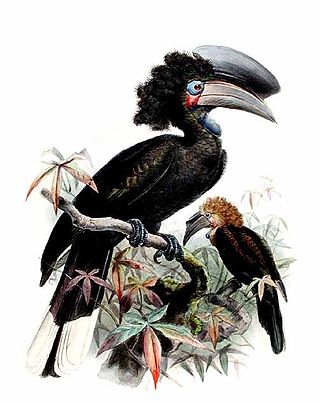
Ceratogymna is a genus of large, primarily frugivorous hornbills found in the humid forests of Central and West Africa. They are sexually dimorphic: males are all black, while females have brown heads and a smaller casque. Unlike the members of the genus Bycanistes, the two species in the genus Ceratogymna have extensive, primarily blue, bare facial skin and dewlap, and the only white in their plumage is in the tail.

The green wood hoopoe is a large, up to 44 cm (17 in) long tropical bird native to Africa. It is a member of the family Phoeniculidae, the wood hoopoes, and was formerly known as the red-billed wood hoopoe.

Bycanistes is a genus of medium to large, primarily frugivorous hornbills found in the forests and woodlands of Sub-Saharan Africa. They have often been included in the genus Ceratogymna, but today most authorities consider them separate. All species in this genus have black and white plumage. The plumage of the sexes is similar, but the casque of the male is larger than that of the female.

The African grey hornbill is a member of the hornbill family of mainly tropical near-passerine birds found in the Old World. It is a widespread resident breeder in much of sub-Saharan Africa and the southwest of the Arabian Peninsula. The African grey hornbill has escaped or been deliberately released into Florida, USA, but there is no evidence that the population is breeding and may only persist due to continuing releases or escapes.

The rhinoceros hornbill is a large species of forest hornbill (Bucerotidae). In captivity it can live for up to 35 years. It is found in lowland and montane, tropical and subtropical climates and in mountain rain forests up to 1,400 metres in Borneo, Sumatra, Java, the Malay Peninsula, Singapore, and southern Thailand.
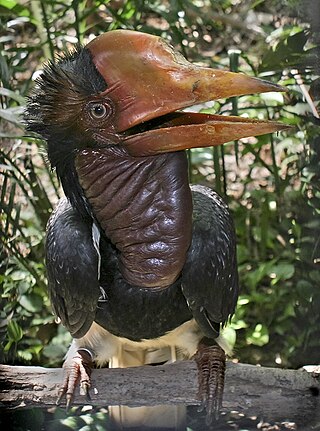
The helmeted hornbill is a very large bird in the hornbill family. It is found on the Malay Peninsula, Sumatra, Borneo, Thailand and Myanmar. The casque accounts for some 11% of its 3 kg weight. Unlike any other hornbill, the casque is almost solid, and is used in head-to-head combat among males. It is a belief among the Punan Bah that a large helmeted hornbill guards the river between life and death.
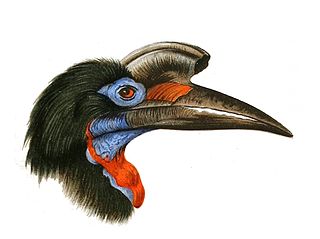
The ground hornbills (Bucorvidae) are a family of the order Bucerotiformes, with a single genus Bucorvus and two extant species. The family is endemic to sub-Saharan Africa: the Abyssinian ground hornbill occurs in a belt from Senegal east to Ethiopia, and the southern ground hornbill occurs in southern and East Africa.
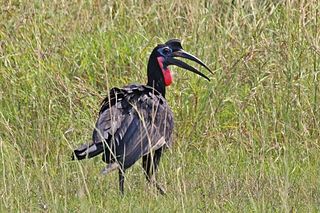
The Abyssinian ground hornbill or northern ground hornbill is an African bird, found north of the equator, and is one of two species of ground hornbill. It is the second largest species of African hornbill, only surpassed by the slightly larger southern ground hornbill.

The great hornbill, also known as the concave-casqued hornbill, great Indian hornbill or great pied hornbill, is one of the larger members of the hornbill family. It occurs in the Indian subcontinent and Southeast Asia. It is predominantly frugivorous, but also preys on small mammals, reptiles and birds. It has been listed as Vulnerable on the IUCN Red List since 2018. It is known to have lived for nearly 50 years in captivity. Due to its large size and colour, and importance in many tribal cultures and rituals, the Government of Kerala declared it as the official Kerala state bird.
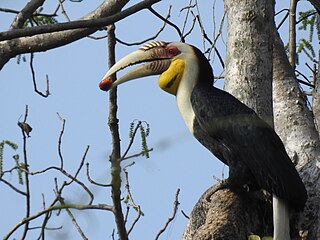
The wreathed hornbill is an Old World tropical bird of the hornbill family Bucerotidae, also called bar-pouched wreathed hornbill due to its distinctive blue-black band on its lower throat sac. It is named after its characteristic long, curved bill that develops ridges, or wreaths, on the casque of the upper mandible in adults. Males are black with a rufous crown, a white upper breast and face, and a yellow featherless throat. Females are uniformly black with a blue throat and are slightly smaller than males.

Bucerotiformes is an order of birds that contains the hornbills, ground hornbills, hoopoes and wood hoopoes. These birds were previously classified as members of Coraciiformes. The clade is distributed in Africa, Asia, Europe and Melanesia.

The black-and-white-casqued hornbill also known as the grey-cheeked hornbill, is a large black and white hornbill. It has an oversized blackish bill with a large casque on top. The female is slightly smaller than the male and has a significantly smaller casque. It is a monogamous species, and pairs nest in suitable tree cavities. The female usually lays up to two eggs. The diet consists mainly of figs, fruits, insects and small animals found in the trees.
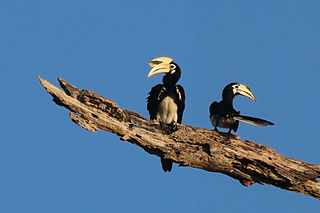
The oriental pied hornbill is an Indo-Malayan pied hornbill, a large canopy-dwelling bird belonging to the family Bucerotidae. Two other common names for this species are Sunda pied hornbill (convexus) and Malaysian pied hornbill.
The brown-cheeked hornbill is a species of hornbill in the family Bucerotidae. It is found in Ivory Coast, Ghana, Guinea, Liberia, Sierra Leone, and Togo. Its natural habitats are tropical and subtropical moist broadleaf forests, plantations, and secondary growth forests. It is threatened by habitat destruction, as timber is harvested and the forests become increasingly fragmented.
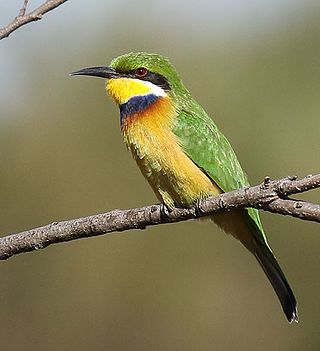
The blue-breasted bee-eater is a central African species of bird. It is a member of the family Meropidae. Meropids are all visually similar and have a diet specialized in Hymenopterans.

The northern red-billed hornbill is a species of hornbill in the family Bucerotidae. It is found from southern Mauritania through Somalia and northeast Tanzania. There are five species of red-billed hornbills recognized, but all five were once considered conspecific and some authorities still classify the others as subspecies of Tockus erythrorhynchus.

A casque is an anatomical feature found in some species of birds, reptiles, and amphibians. In birds, it is an enlargement of the bones of the upper mandible or the skull, either on the front of the face, or the top of the head, or both. The casque has been hypothesized to serve as a visual cue to a bird's sex, state of maturity, or social status; as reinforcement to the beak's structure; or as a resonance chamber, enhancing calls. In addition, they may be used in combat with other members of the same species, in the gathering of food, or in thermoregulation.



